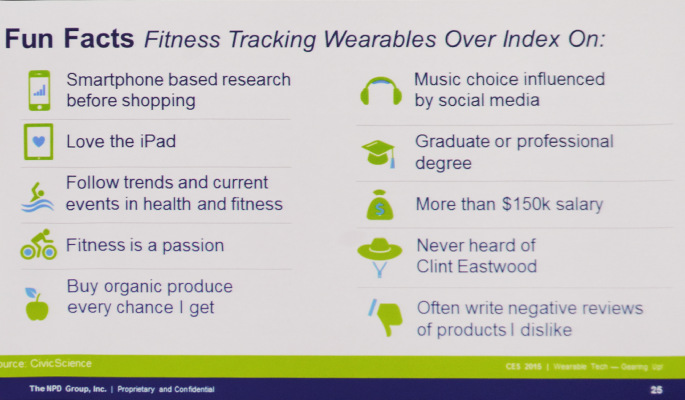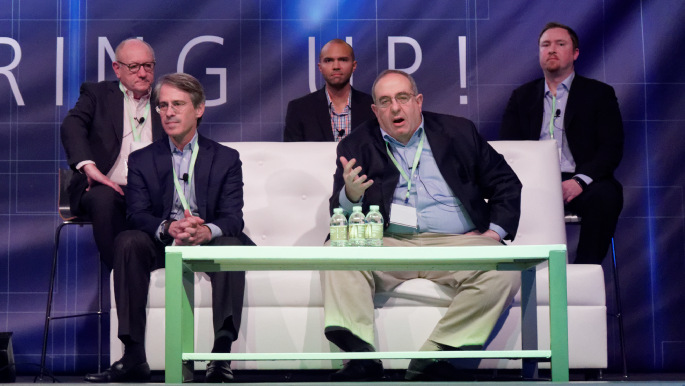NPD held its annual event at CES and we have reported and enjoyed it for a number of years. We loved it in years gone by when Ross Young of DisplaySearch made his “death by powerpoint” talks, but I guess we’re in a minority! These days, the events have become much more about opinion, as they are run by analysts from NPD (DisplaySearch now having joined the IHS empire).
Karen Grant, COO and President of NPD started by saying that she is very happy now that CES has become an event that includes fashion and fitness to technology. NPD has a long history in tracking fashion and sportswear. Grant said that 54% of wearables are worn by women, and they don’t like rubber jewelry!
Eddie Hold is the head of the NPD wearables service. He was joined on stage at the Treasure Island hotel for an evening panel session, by Ben Arnold, Wes Henderek, Stephen Baker, Matt Powell and Andy Mantis.
Hold said that 42% of activity tracking owners last year gave up using their trackers. Although Grant was enthusiastic, the reality is that most consumers are not maintaining their interest.
Arnold said that he is more positive than Hold – he thinks that the statistic for the lack of use of gym memberships is even more negative than for trackers and given that fitness needs the same motivation, you should expect the same type of trend. Henderek said that buyers had high expectations, which were maybe a bit too high. Knowing just the number of steps taken doesn’t provide the level of data to manage performance, so interest tends to wane rapidly. It also takes time for new products to reach the mass market. NPD’s indicators show that fitness trackers are starting to enter the mass market now, so there will still be growth in the market.
What’s next is new use cases, there is a lot of work to be done, for example in sleep tracking and stress level managment (using breathing and heart rate analysis).
Smart watches and other devices might take over from wearable. Arnold said that it depends how optimistic you are about smart watches. On the other hand, smartwatches are quite expensive, so the future of fitness markets may depend on the prices of smartwatches. Smartwatch buyers are clearly early adoptors and the market is quite small at around $110 million.
Smartwatches could fall into a hole between two sets of users. Older people have watches and older users are unlikely to give up their watches (watches may be heirlooms) to buy a smartwatch, but younger consumers don’t have watches at all. Smartphones suddenly became a big market and smartwatches may need compelling applications to grow as fast.
There is no “killer app” for smartwatches – users and potential buyers have a range of planned uses (and are a diverse bunch, we liked this slide from the presentation, but a point not on there is that fitness tracker buyers are twice as likely to think they were more attractive than average!)

Hold asked what the key apps for smartwatches are? Henderek said that buyers tend not to think of smartwatches as peripherals to smartphones – they want them to work in a stand-alone mode and that means a need for 3G connectivity and consumers also want waterproof systems.
Arnold said that there are opportunities for games on smartwatches.
Hold asked if you really need a smartwatch if you have a phone? Phones are getting bigger so that may leave room for a smaller device.
Arnold expects to see increasing specificity in devices – this is a trend that NPD sees in other segments.
Stephen Baker and Matt Powell were next to speak. There are 70 different fitness trackers on sale now and Baker said that there is a rush to enter the market. That’s like the TV market, where there are many brands of TVs. In fitness trackers, as the market grows, more brands will enter the market.
Hold asked if retailers know where to put their fitness trackers in their stores? With the electronics or with the sports or health products?
 Baker said that retailers are keen to enter the market and will have a wide range of brands and products on offer. Consumers buy fitness trackers from a lot of different retail locations. In the last quarter of 2014, sports retailers started to devote space to selling technology in store. Baker said that it is often less obvious where to put the electronics products. Traditionally sporting goods stores have a bad history of selling equipment of all sorts, so its not obvious that they can succeed, although devices such as GPS trackers are having some success.
Baker said that retailers are keen to enter the market and will have a wide range of brands and products on offer. Consumers buy fitness trackers from a lot of different retail locations. In the last quarter of 2014, sports retailers started to devote space to selling technology in store. Baker said that it is often less obvious where to put the electronics products. Traditionally sporting goods stores have a bad history of selling equipment of all sorts, so its not obvious that they can succeed, although devices such as GPS trackers are having some success.
Baker said that the best thing about wearables is that it’s a new market and new opportunity. NPD has found that users of fitness trackers typically excercise multiple times per week, but don’t go to gyms.
The final speakers were Henderek agin and Andy Mantis
Some consumers love Apple more than any other brand. Apple consumers are very loyal and will buy the product, just because it’s from Apple. It remains to be seen whether it’s a technology that “goes in the drawer” or whether it actually gets used. A point to remember is that traditional watches last for a long time, but smartwatches are likely to be obsolete quite soon. Apple lovers are mostly not in the market at the moment as Apple doesn’t have products, although they will do soon.
Buyers of Nest are early adopters of wearables, so this is an early adoptor market.
In questions, a retailer asked if the market is not clear, its hard to decide the shelf space to be given to it. Baker said that there is a process with all new categories, but as the market develops, it will become clearer which the important products are.
Some brands are better recognised, but brand loyalty in fitness and sports goods are high and will drive purchases.
A second question was about data privacy. Powell said that most consumers have already given up more data than they realise. Hold said that there is a culture among some people of sharing, which may not apply to others. Baker said that real data will come out of big samples and big data about sports activities to really learn what drives the improvement in performance.

